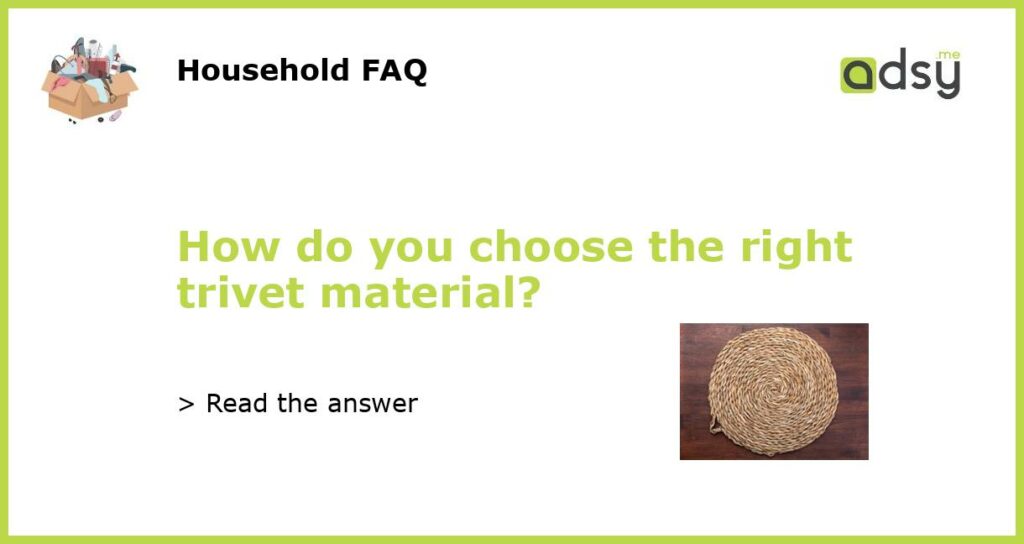Choosing the Right Trivet Material: A Comprehensive Guide
When it comes to choosing a trivet for your kitchen, it’s important to consider which material is best suited to your needs. The trivet material plays a crucial role in protecting your countertops from heat and preventing damage to your kitchen surfaces. With so many options available, it can be overwhelming to make the right choice. In this guide, we will explore some popular trivet materials and their pros and cons, helping you choose the perfect trivet for your kitchen.
Silicone Trivets: Versatile and Heat-Resistant
Silicone trivets have gained popularity in recent years, thanks to their heat resistance and versatility. These trivets can withstand high temperatures, making them ideal for protecting your countertops from hot pots and pans. They are flexible, allowing for easy storage and handling. Silicone trivets also provide a non-slip surface, ensuring your cookware stays in place while protecting your surfaces.
Pros:
- Heat resistance
- Flexibility
- Non-slip surface
Cons:
- May stain over time
- Can attract dust and lint
- May not be suitable for heavy pots and pans
Wooden Trivets: Elegant and Natural Appeal
Wooden trivets are a classic choice that adds a touch of elegance to your kitchen. They are known for their natural beauty and durability. Wooden trivets are highly effective at insulating your countertops from heat, as wood is a poor conductor of heat. They also protect your surfaces from scratches caused by pots and pans. However, it is important to note that wooden trivets may be more prone to warping or cracking with prolonged exposure to heat or moisture.
Pros:
- Natural beauty
- Durable
- Good heat insulation
Cons:
- Can warp or crack with prolonged exposure to heat or moisture
- Require regular maintenance and oiling
- May not be suitable for heavy pots and pans
Cast Iron Trivets: Heavy-Duty and Timeless
Cast iron trivets are known for their robustness and timeless appeal. These trivets are extremely durable and can handle heavy pots and pans without any issue. They provide excellent heat distribution and retention, ensuring maximum protection for your countertops. Cast iron trivets also have a rustic and vintage charm that adds character to your kitchen. However, they can be quite heavy and may scratch or damage delicate surfaces if not used correctly.
Pros:
- Durable and long-lasting
- Excellent heat distribution and retention
- Rustic and vintage appeal
Cons:
- Heavy
- May scratch or damage delicate surfaces
- Require careful handling and storage
Cork Trivets: Lightweight and Eco-Friendly
Cork trivets are a popular choice for those looking for a lightweight and eco-friendly option. These trivets are made from the bark of cork oak trees and are highly sustainable. They provide excellent heat insulation and are gentle on delicate surfaces, preventing scratches and damage. Cork trivets also have a natural antimicrobial property, making them resistant to mold and mildew. However, they may not be as heat resistant as other materials and may not be suitable for heavy pots and pans.
Pros:
- Lightweight
- Eco-friendly and sustainable
- Good heat insulation
Cons:
- May not be as heat resistant as other materials
- May not be suitable for heavy pots and pans
- Require regular cleaning to prevent stains
Finding the Perfect Trivet Material for Your Needs
Choosing the right trivet material for your kitchen is essential to protect your countertops and prevent damage. Silicone trivets offer versatility and heat resistance, while wooden trivets add a touch of elegance to your kitchen. Cast iron trivets are heavy-duty and have a timeless appeal, while cork trivets are lightweight and eco-friendly. Consider your specific needs and preferences before making a decision. Remember to care for and maintain your trivet properly to ensure its longevity and effectiveness in protecting your kitchen surfaces.






